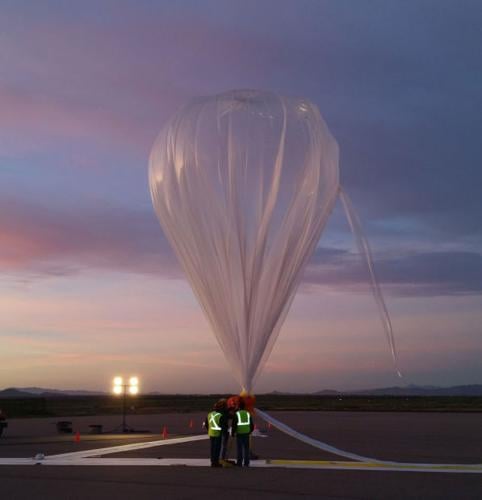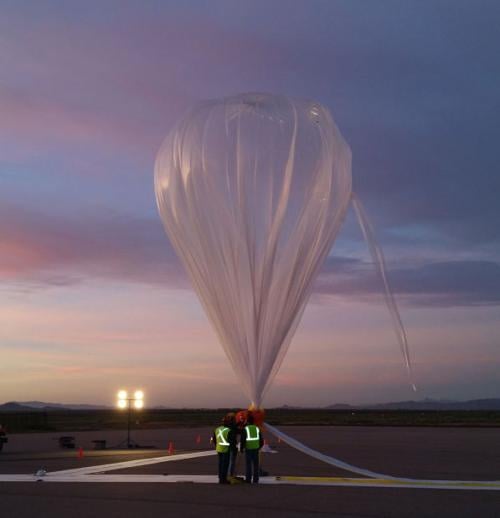Commercial space tourism is one step closer to being a reality.
Last month, World View Enterprises Inc., a Tucson-based commercial balloon spaceflight company, successfully flew the first parafoil, a wing-like parachute, from the edge of space.
Though the company has flown a high-altitude balloon at that height before, this is the first time a parafoil has been flown at 102,200 feet, which is roughly the altitude it hopes to fly passengers.
Instead of being propelled by a rocket, World View’s vessel is attached to a lighter-than-air helium-filled balloon that lifts it off the ground. The gentle ascent 20 miles above Earth takes one to two hours as the balloon expands and decreases in density.
The craft will hover at the target altitude in the stratosphere for around two hours, and the goal is to give six passengers — who will pay $75,000 for a seat — time to admire the view, and researchers time to conduct experiments.
To return to the ground, the pilot releases helium from the balloon. At around 50,000 feet, the balloon separates and a parafoil guides the capsule the rest of the way down to a landing site, which could be as far as 300 miles away from the launch site. A private plane will take passengers back to the starting location.
Prior to February’s test flight, the highest a parafoil had flown was 15,000 feet. At 102,200 feet, there is limited air pressure and density, which makes deployment more difficult.
“Unlike in lower altitudes where a parafoil starts getting hit by a lot of air that allows it to inflate, there are very little molecules up there to interact with the parafoil,” said Sebastian Padilla, World View’s chief engineer.
World View has partnered with United Parachute Technologies to design a parafoil that will work at such a high altitude. Padilla said United Parachute Technologies’ long history with creating parachutes made the partnership a good fit.
The test flight launched from Marana Regional Airport and the balloon headed east, floating in the air for a little over an hour before landing in New Mexico.
The parafoil tested was smaller than the one they’re planning on using for a full-sized capsule. While this meant that the flight’s payload was lighter and had no people on board, there were experiments from two universities in the payload. Besides manned spaceflight, advancing research is another one of World View’s goals.
Montana State University tested a computer system designed to work in extreme environments, while the University of North Florida tested experimental technology for measuring the stratosphere’s ozone gas profile.
“One of our markets is to fly science payloads,” said Taber MacCallum, World View’s chief technology officer. “We wanted to start off flying a couple of science payloads to understand what it takes to do that — to interface with the researcher, their payload and their science and have a flight under our belts.”
During the next test flight, MacCallum said, they hope to include two NASA experiments on the payload.
Next, Padilla said they’re planning to continue testing, increasing the size of the parafoil and the payload until they reach the approximate weight of the capsule, which is around 9,000 pounds.
MacCallum hopes to be in manned flight-testing toward the end of 2016 or early 2017.
“We won’t fly people until we know it’s very safe,” MacCallum said.
One of the biggest challenges for the company was determining how the Federal Aviation Administration was going to regulate World View and whether they’d be licensed as a commercial balloon or a spacecraft. MacCallum said they spent 18 months working with the FAA on how they will be licensed as a spacecraft.
They also worked with former Republican legislator Ethan Orr last year to pass state legislation, which limits the liability of a space flight company if a space flight participant signs a liability release agreement.
“Now we know what our regulatory regime is going to be and we’re working on the engineering to meet those regulations,” MacCallum said.
Funding was also a big concern, though MacCallum said they had a very successful funding round toward the end of last year.
“These really big problems got addressed early on so now we’re in that phase where there’s just a lot of work we’ve got to do,” MacCallum said.
While there are other space tourism companies in competition with World View, such as XCORP and Virgin Galactic, the use of rockets is a very different experience from the helium balloons World View is employing.
“They offer a rocket ride into space, you’re in space for a few minutes and then you come back down,” MacCallum said. “Hopefully you didn’t blink while you were at the top.”
Steve Kortenkamp, senior scientist at the Planetary Science Institute, said he believes this approach to space tourism has its advantages when it comes to research.
“Researchers that want to do very high altitude studies could have a much easier time sending something on one of these flights rather than getting a NASA rocket,” Kortenkamp said. “It could save a lot of money and allow for easier maintenance of the instruments.”
Based on other space- tourism ventures that have already been selling tickets and compiling wait lists, Kortenkamp said he believes there are plenty of people with the interest and the means to afford the prices they’ll charge.
“I think it just comes down to the safety issue,” Kortenkamp said. “Can they demonstrate that it’s a reliable thing?”







